Total cost of Ward's cabin solar power system : Less than 700 Bucks!
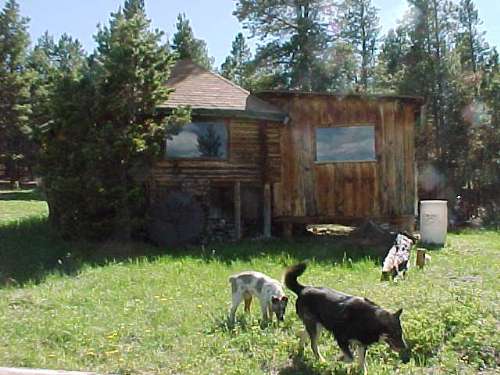
Ward thought carefully about what electrical appliances he needs to run at his new home. It's important to do this before planning and purchasing your power system! He's a bachelor, but still wanted enough 'stuff' for a comfortable lifestyle. Here's what he came up with for essential items:
- Lighting--all lights to be high-efficiency. 120 VAC compact fluorescent (CF) lighting was chosen because bulb cost is so cheap compared to 12VDC CFs ($50/ea for 12VDC, $9/ea for 120VAC)
- 120 VAC CF room light, 9 watt
- 120 VAC CF light over kitchen counter area, 6 watt
- 12 VDC halogen light in bedroom, 20 watt (this way he can turn off the inverter before bed to save power, and still have light to get back to the bedroom). Plus, halogen lights are better for reading
- 120 VAC Halogen outdoor spotlight, 50 watt....there's bears, cougars, and rogue moose up here all the time. Better to see them first when you have to visit the outhouse at 3 AM!
- TV/VCR--We have about zero TV reception up here...so it's hard to waste much power on television. So Ward bought a little 13 inch color TV, rated 54 watts (though in normal use it draws only about 25 watts), and brought up his VCR from town. Winter nights up here are long and dark, and movies can save you from serious depression!
- Boom Box--Get the CHEAPEST one available. Why? Because Fancy stereo/TV equipment that lets you turn it on and off with the remote will draw power even when it's turned off!!! The inexpensive model he bought has a hard-wired on/off switch, and wastes no power (called a 'phantom load') when off.
- Future Needs--always remember to factor these in when designing a system! Eventually he might put in pressurized water (with a 12VDC pressure pump), more lights, etc.
- Non-Electric Appliances--these can save you lots of money on solar panels and batteries. The 'downtown' versions suck up electricity fast, but these simple alternatives are far more efficient.
- Refrigerator--Propane, RV size. Less than $200 used from an RV dealer, uses very little propane so it can be run off of 40 lb. portable tanks. Ward's road is too rough for propane trucks.
- Heating--Woodstove, from Harbor Freight.
- Cooking--Propane cooktop, used from an RV dealer.
- Water Heating--A big pot of water on the woodstove!
- Plumbing--Maybe a pressurized water system in the future, but just a sink with an outside drain and 5-gallon buckets for now.
- Outhouse--The outhouse works just fine, is not subject to mechanical breakdown, and uses no electricity. TIP: During winter when it's 20 below zero outside, keep the toilet seat in your house near the stove, and bring it with you when you have to visit the outhouse!
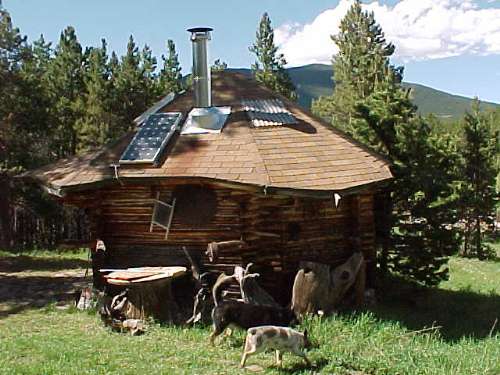
South Side of Cabin Showing Solar Panel. Shading is from trees...Ward's planning on some chainsaw work, both for solar exposure and wildfire protection! That's DanF's dogs, Kodiak and Tarmac, in the picture.
System Components
- Battery Bank--4 golf cart batteries. 6 VDC, 220 amp/hours, only $45.99 each from Sam's Club. Wired in series and parallel, these give 440 amp/hours of storage. That's more than enough for the minimal loads in the cabin, especially when you consider that the owner is away from home at work during the day, giving the system time to charge back up.
- Solar Panel--BP 75 watt, from an internet distributor. $310 new, plus $20 for shipping. Wired to contoller and battery bank with #10 Romex.
- Solar Panel Mount--Home built from 1 inch aluminum angle, adjustable for summer and winter positions. About $20 total for aluminum stock, nuts, and bolts.
- Charge Controller--An industrial model from Jade Mountain, rated for 16 amps (to provide room for adding more solar panels later), and cost only $62. Ward had to buy 2 fuse holders and 20 amp fuses, mount this controller on a home-made aluminum heat sink and build a cover himself....but for the price he'll be able to add 2 or 3 more solar panels without a new controller.
- Inverter--A 350-watt Wagan from Harbor Freight, only $40. Includes fuse on main power cable and overload shutdown. DanB has used one of these for a year, heaping abuse and neglect on it, and it's performed like a champ. The only drawback of this model is that the fan is on all the time, and produces a little noise. Ward plans to to turn the inverter off at night, and during the day while he's at work.
- Metering--Cheap digital multimeter, only $10. Not real accurate, but enough to determine general battery state of charge. Plus, the controller has an LED to indicate full charged condition.
TOTAL SYSTEM COST: Less than 700 bucks!
Battery Bank -- 4 Golf Cart Batteries
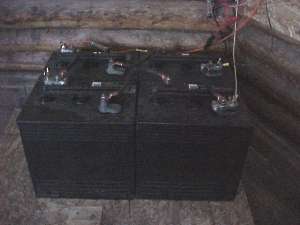
Power Panel with Inverter and Charge Controller
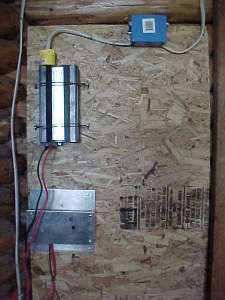
BP 75 Watt Panel
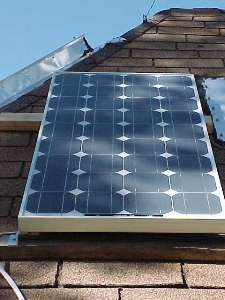

It would be impossible to power a home down in town with a system of this size...but this design goes to show that if you are conservative with your power use, realistic with your expectations, and thrifty with your equipment purchases, you can power up a home for under a grand. Just don't try to plug in that damn air conditioner!
SOURCE: Other Power
